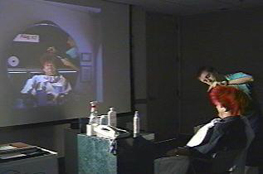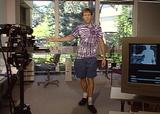
A. Yes

So you've been asked to give a talk in front of a seminar--or possibly in front of a much larger audience. Or maybe you've been giving lots of talks, but you wonder about how you can make your talks more effective?
The purpose of this page is to present some ideas about presentation style. These are all surface issues and do not address the actual content of your talk (because it is, of course, spectacular). Every single point can be argued, so a justification for the point is given. If you disagree with a point and want to state a reason why you disagree, or have additional tips to share, please send a message and your comments will be included if they're reasonable.)
 |
||
| Q. Will the
audience be annoyed if you sit instead
of stand? A. Yes |
||
One of the most important things you can do is watch other speakers. Figure out what you like and what you don't like about what they do and then try to do or not do those things. Ever been annoyed at a speaker who puts of an overhead with such tiny print you can't read it at all? Then be sure you use a larger font. How about those people who constantly block the screen so you can't see it? Maybe you should try not to do the same thing.
Great speakers sometimes codify their techniques. You should read Patrick Winston's Lecturing Heuristics.
Use large fonts. Anything smaller than 24 point is probably a mistake. If you photocopy a paper from a book and project that, you deserve severe punishment. The only exception is if you are trying to impress the audience with the density of something, or otherwise make a point that specifically requires dense and unreadable text.
 |
||
| Use figures instead of words! | ||
Use lots of figures. A picture is worth a thousand words. If your work is very mathematical, try to develop a talk that is entirely in pictures. Then go back and add one or two words per slide.
Do not use a pointer. A pointer seems particularly useful if you cannot reach the projection. Those laser pointer things seem totally cool, too, don't they? Well, they're annoying and should be outlawed. Why?
| Pointers are guaranteed to annoy at least 35% of your audience. |
It's ok if your hand makes a slight noise when you hit the screen, or the screen shakes. This discontinuity may wake a few people up. Seriously.
Watch the time. Try not to go over your given time. Even if you start late, it's a courtesy to the audience to end as close to on time as possible. A good lecture room will have a clock positioned so that you can see it. (A spectacular lecture room will not have one positioned where the audience can see it, so they're less likely to fidget.) Pay attention to it. If you're running behind, skip a slide, or gloss over one, or talk a bit faster, or don't accept questions. Yes, your work is exciting and interesting, but your audience has other appointments, too. If not, they'll talk to you afterward.
Walk in front of the screen occasionally. This one seems kind of silly, but it serves two purposes. First, it gets you to the other side of the room so that the people on that side will have you in the way of the projection (only sometimes since you'll usually be up near the screen); it is only fair to share the discomfort. Second, the sudden bright flash of light reflecting back to the audience as you break the projection beam will wake a few people up. Seriously.
Talk to the audience, not the screen. This sounds simple, but it's amazing how many people look at the screen and talk at it rather than at their audience. If you haveto face the screen, speak a bit louder while you're facing it so that your voice will reflect from it and back to the audience. Better: don't talk to the screen. Contort your body, or point at the screen and then turn around.
Do not read your slides to the audience. Why would I want to come to your talk to hear you read your slides? Unless you're a famous poet or novelist reading your own work, what is the point? (Not even sure there's a point then.) The slides should be an outline of the talk to help the audience follow what you're saying. Or complex equations or pictures or something that you can't convey easily with words. A simple trick is to leave out all of the articles and connectives--e.g., "simple trick: omit articles, connectives". Then if you have no better imagination, you can read it back to the audience with the articles and connections put back in. At least your presence serves a purpose then.
 |
||
| Props good, fire bad. | ||
Use props. Talks are about show and tell and keeping your audience amused, so you can inform them painlessly about what you are doing. Whenever possible, bring and use props: videotapes, robots, pieces of robots, models of molecules, a gear your algorithm machined, circuit boards implementing your algorithm in silicon, etc. However, if you use videotapes, be sure to have them cued up beforehand and practice turning them on and off so it goes smoothly.
Use color. It used to be that you could use LaTeX and make black & white slides for a talk. This worked, because LaTeX typeset things nicely, and no one had color printers. Now we do have color printers (and copiers, and 35mm slides) and black LaTeX slides look (a) all the same and (b) boring. Monochrome slides give the impression you are not colorful either. These days, there is no excuse for a monochrome talk. Use colored pens if you are making your talk by hand. If you're using the computer, use color LaTeX or Powerpoint, or Adobe Illustrator, and print out your slides on a color printer. For better or worse, audiences these days expect color; it's easy to use, and you can convey more information with it.